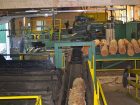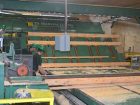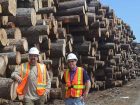
Features
Mills
Sawmilling
Raising the roof
October 26, 2015 - When Hefler Quality Lumber decided to upgrade its sawmill last March, they didn’t expect to be undergoing a ton of renovations. But after a harsh winter storm collapsed a section of the roof and walls within the Middle Sackville, N.S. mill, the company was forced to increase the scope of the facility’s upgrades.
October 26, 2015 By Andrew Snook
 The sawmill used to process spruce When Hefler Quality Lumber decided to upgrade its sawmill last March
The sawmill used to process spruce When Hefler Quality Lumber decided to upgrade its sawmill last MarchThe collapse took place on March 5, and logs didn’t re-enter the mill again for processing until the second-last week of May.
“Every day we’re sawing a little bit more,” says Blair Saulnier, general manager for Hefler Quality Lumber. “Now it’s just a matter of learning the equipment and working out the bugs. But the fact that we turned it around in about 72 days is pretty impressive.”
When Hefler was sold by the Prest family to a group of local shareholders, the new owners knew that the mill had the potential to produce 10 to 12 million board feet annually. Saulnier, who had previously worked for the mill from 1993 to 2002, also knew the capabilities of the mill, which was underperforming.
“It took us most of last year to get it up to its capacity of about 40,000 fbm a day, as the mill was in very bad condition when we took over in late 2013,” Saulnier says.
But following approximately $2.8 million in equipment and building upgrades, the mill now has a capacity of 70,000 bdft. per day. As of early September, the mill was producing 56,000 bdft. daily. With the new upgrades, the mill is expected to produce somewhere between 18 and 20 million fbm annually.
“As with all new renovation and upgrade projects, engineering is key to success, but you never can identify all the sources of loss until the start-up process has begun,” Saulnier explains. “We continue to identify and create solutions to areas causing loss of production and will soon reach our goals.”
Sprucing up the mill
The sawmill used to process spruce, hemlock and pine, focusing heavily on the local pine market, but now it operates solely on spruce and hemlock. It produces dimensional lumber and decking, but has plans to differentiate itself from other mills in the area by focusing on producing premium wood products, not just the standard products.
“We’re a smaller mill, so we have to focus on creating a premium product,” Saulnier says.
Moving forward, the mill will focus on decking and framing lumber, as well as custom work by the trailer load.
“We’ll still do timber framing hemlock 6x6s, 8x8s and 12x12s,” Saulnier says. “We still have the capacity to do all that.”
The company used to sell its lumber to wholesale and retail outlets, but back in February the company made the move to supplying only wholesale channels.
“It’s just because of the sheer volume and loss of productivity that occurs when trying to cater to the retail market,” Saulnier says.
The re-designed sawmill can now process logs upwards of 22 feet in length and 30 inches in diameter.
“The mill can do 1x3s up to 2x12s and 6x6s and be trimmed at both ends,” says Saulnier. “We can saw much bigger timbers than 6×6, but they have to go out a different route and are hand trimmed.”
Equipment upgrades
Most of the equipment and infrastructure for the operation has either been rebuilt, replaced or is new, starting at the company’s rebuilding of its Valon Kone VK800 debarker, used for processing up to 30-inch logs and its Forano RVF 26 debarker, used to process logs with diameters smaller than 18 inches.
“The sawmill upgrade and renovation saw the entire mill go through a modernization,” Saulnier says. “Everything from electrical upgrades to equipment software upgrades to new hydraulics and air systems were installed due to the roof collapse and subsequent damages. These systems were installed using some of the best and latest technology and safety features available.”
The collapse destroyed the mill’s MCC panel and entire electrical room, but Hefler just viewed it as an opportunity to optimize their operations.
“All the old wiring was damaged and removed and new wires were pulled and replaced,” Saulnier says. “By doing that we made everything in the mill PLC controlled. Even though we still have some older equipment operating here, everything can be adjusted through a laptop to the PLC, all 2015 technology.”
Hefler also replaced its 1984 HMC Carriage with a 2000 Cardinal 4 Bunk Carriage and replaced the programming with a new 2015 Mudata DIV601 and DIV603 system to operate the setworks. The company had purchased some of the equipment from a Caledonia, N.S. mill, previously called L&S Douglas, which had gone into receivership.
“When the roof collapsed, it wasn’t our intention to replace the carriage or the head rig,” Saulnier says. “But when the roof came down it blew the walls out as well, so three days after the collapse we had no choice but to tear it right down to the floorboards in order to re-build properly.”
The mill also replaced its PHL D6-54 edger with a Valley Machine 8” edger system with redesigned infeed systems; and installed a new Comact horizontal resaw on the backside of the edger outfeed with automated setwork controls for shifting the resaw between one-inch and two-inch product cuts. The top size logs being processed on the smaller line went from eight inches to 16 inches.
“This allowed us to produce larger diameter logs on the small line, increasing that line’s production by 30 to 40 per cent,” Saulnier says.
Hefler also installed an automatic unscambler for separating product as it flows out of the horizontal resaw; and a new TS Manufacturing 10-shaft trimmer saw to increase the accuracy and quality of its trim cutting.
Another improvement made to increase mill efficiencies was a ScanMeg log scanner, which will be tied into the tally system so the operators will know what they should get out of the logs they are processing, and what they are actually getting out of the logs.
“It’s all about recovery,” Saulnier says. “It’s crucial that we get the most that we can out of each log.”
The process
After logs are fed into one of the two debarker stations, the log scanner decides which line the log will travel down, although the operator has the ability to override, if necessary, to keep the line at maximum production levels.
“The logs that go to the small line are sent to a set of over and under PHL Twin saws which cant the log, basically turning it into a square and then bring it back over to the centre where it gets diced up into 2x4s, 2x6s and 2x8s on the gang side of the edger,” Saulnier says. “All larger diameter logs are kicked to the big line or the carriage saw where our sawyer will make the most out of the log – typically 2×10, 2×12 or squares, depending on the orders at the time.”
All the cants and the boards then go through the Valley Machine edger, then through a horizontal resaw in the outfeed so it’s all done in one pass.
The dimensional lumber and boards are then sent to the TS Manufacturing 10-shaft trimmer saw for trimming and are tallied, then sent out to a green chain for piling. Each person on the green chain piles 8,000 fbm per day, on average. From there, the lumber is taken to the rough lumber yard until it can be dried in a Coe dry kiln. The kiln is more than 20 years old, but was upgraded in 2014 with new concrete and tracks, and any leaks were sealed. New MEC hardware and software was also installed and the kiln is now working as it did in its early years.
From there, the lumber is finished with either a re-built A-20 Planer or the mill’s vintage, but also re-furbished, Newman Planer.
Bio-business savvy
One of the reasons the sawmill was purchased by local shareholders was because of its potential to operate as a biomass-fuelled power generating station, which was commissioned this past summer.
It is also one of the reasons Saulnier was hired on as the mill’s general manager. Saulnier was hired because of his previous work experience with the sawmill and 10-plus years working for an engineering company that specialized in troubleshooting and commissioning – as well as some design – of various boiler plants and other biomass facilities similar to the one built for Hefler Quality Lumber.
Hefler signed a 20-year contract to supply power from its biomass generator to the grid as part of the Province of Nova Scotia’s community feed-in tariff program.
“One of the reasons this mill was a great fit was its accessibility to the grid,” Saulnier says. “The substation is less than a half-a-kilometre away, which is not often heard of, and the existing sawmill was already producing waste that could be used as its fuel source. With all the challenges of having a sawmill in a very competitive marketplace, sawmills need to start thinking outside the box to find other ways to generate revenue in order to survive, which in turn creates long-term employment. In our case, our solution was to produce 3.1 megawatts of power for Nova Scotians.”
The sawmill’s original intent was to supply 50 per cent of its biomass to the generator and then buy the rest, but due to rising costs for harvested biomass they decided they needed to be self-sufficient. This was another driver behind the most recent upgrades to the mill.
“We don’t know what fuels are going to do over the next 20 years and that’s what we have a contract for, so we decided to do a sawmill upgrade that would let us produce 18 to 20 million fbm. This allows us to be self-sufficient,” Saulnier explains.
In the past, Hefler sold all its bark to a landscaping company, but now they hog it and burn it for fuel.
“Sawdust and shavings are the same thing, chips too, if it’s required. We want to continue to sell them to pulp and paper mills but if we need them, we burn them,” Saulnier says.
Half-full
After seizing the opportunity to replace and upgrade the old equipment in the mill, Hefler Quality Lumber is now in a better position to meet the needs of its customers, grow its operation and become a self-sufficient biomass power generator for the province. Not a bad response to a roof collapse. Not bad at all.
Print this page


